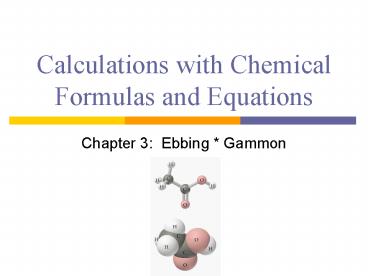Calculations with Chemical Formulas and Equations - PowerPoint PPT Presentation
1 / 17
Title:
Calculations with Chemical Formulas and Equations
Description:
Avogadro's number (NA): The number of particles in exactly one mole of a pure substance. ... 3. CuSO4 * 5H2O [% water in the hydrate] Determining Chemical ... – PowerPoint PPT presentation
Number of Views:83
Avg rating:3.0/5.0
Title: Calculations with Chemical Formulas and Equations
1
Calculations with Chemical Formulas and Equations
- Chapter 3 Ebbing Gammon
2
Stoichiometry
- Study of quantitative relationships that exist in
chemical reactions and chemical formulas. - Composition
- Reaction
3
Relating Mass to Numbers of Atoms
- Mole (mol) the amount of a substance that
contains as many particles as there are exactly
12 g of carbon-12. - SI Unit for the amount of substance.
4
Relating Mass to Numbers of Atoms
- Avogadros number (NA)
- The number of particles in exactly one mole of a
pure substance. It is equal to the value 6.022 x
1023 particles - Particles can be either atoms, molecules, or
formulas units.
1 mol 6.022 x 1023 N
5
Relating Mass to Numbers of Atoms
- Molar Mass
- The mass of one mole of a pure substance.
- Units are given in g/mol
- Molar mass is numerically equal to the atomic
mass (or formula mass)
6
Element atoms (S,C) Ionic compound formula
units (NaCl) Molecular compound molecules (H2O)
7
Percent Composition percent by mass of each
element in a compound
Percent Composition 1. Mass of element in
sample of cpd. x 100 Mass
of sample of cpd. OR 2. Mass of element
in 1 mol of cpd. x 100 Molar Mass
of cpd.
8
Calculate the Composition of 1.
NaNO3 2. Mg(OH)2 3. CuSO4
5H2O water in the hydrate
9
Determining Chemical Formulas
- Empirical Formula
- Consists of the symbols for the elements combined
in a compound, with subscripts showing the
smallest whole number ratio of the different
atoms in the compound. - Molecular Formula
- Consists of the exact types and number of atoms
combined in a single molecule of the compound.
CH vs. C6H6
10
Calculating Empirical Formula
1. Convert percent composition to mass
composition if you are not already given the mass
in grams. 2. The mass composition of each
element is converted to composition in moles by
dividing it by the molar mass. 3. To find a
ratio of small whole numbers divide each mole by
the smallest number in the existing ratio.
11
Empirical Formulas
- A compound is analyzed and found to contain
36.70 K, 33.27 Cl, and 30.03 O. What is the
empirical formula of the compound? - A 60.00g sample of tetraethyl lead has 38.43 g
lead, 17.83g carbon, and 3.74g hydrogen. Find
the empirical formula.
KClO2
PbC8H20
12
How to calculate the molecular formula 1.
Molecular Formula Mass must be given x
Empirical Formula Mass 2. Multiply 'x'
to all atoms in empirical formula.
You must be given the percent composition,
to determine the empirical formula (if not
given), and the molecular mass!
13
STOP HERE!
14
Stoichiometry
- Study of quantitative relationships that exist in
chemical reactions and chemical formulas. - Composition
- Reaction
15
Limiting Reactant
- Limiting reactant the reactant that limits the
amount of product formed because it is the first
that is completely consumed in a reaction. - Excess reactant the substance that is not used
up completely in a reaction.
- LR Problems
- Balance the Equation
- Determine the amount of product produced from
each reactant. - The sample which produces the least amount of
product is the limiting reactant.
How much is left over from the excess Reactant?
16
Percent Yield
- Theoretical yield the maximum amount of product
that can be obtained by a reaction from given
amounts of reactants. - Actual yield is experimentally obtained and may
be less than the theoretical for several reasons. - Loss of sample
- Competing reactions that occur simultaneously
with the reactant on which the theo. yield based. - Reactions stops before completion, and left with
a mixture of reactants and products.
17
Percent Yield
Actual yield__
X 100
Percentage yield
Theoretical yield

